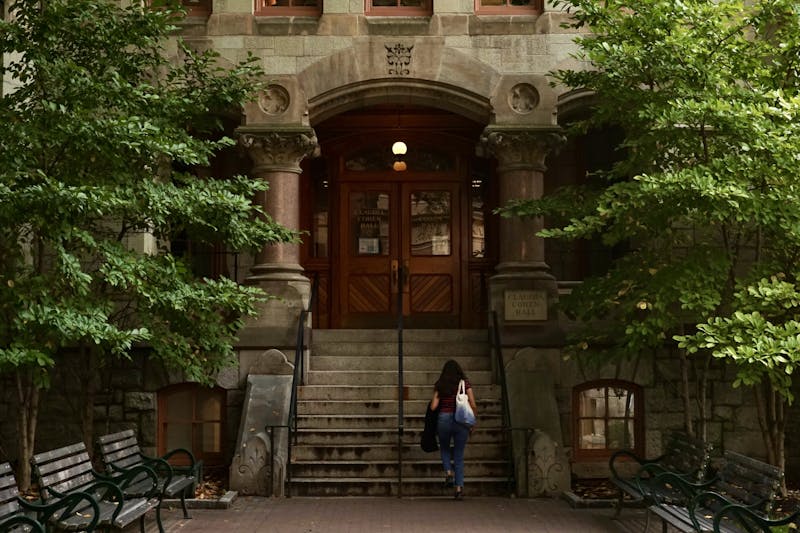For researchers today, perfect isn’t good enough.
“Even with a perfect score, in a highly competitive world, we’re still being cut,” Chris Hunter said. “Even if you get a perfect score, that doesn’t mean you get what you ask for or what they recommend.”
Hunter, the chair of the Department of Pathobiology in the School of Veterinary Medicine, reapplied for a grant that has funded six graduate students in his lab for over 15 years. Despite receiving the highest score possible on the grant application, the National Institutes of Health grant was cut and can now fund only five students. Hunter’s story is far from unique. Nearly six months after a package of massive automatic spending cuts to the federal budget — known as the sequester — went into effect, the scientific community is feeling the squeeze.
Stopping the bleeding
Research at Penn is heavily reliant on federal funding, which constituted 82 percent of the University’s $874 million in research grants in fiscal year 2012. Over half of research awards come from the Department of Health and Human Services, which oversees the NIH, one of the sequester’s hardest-hit agencies.
Recent headlines have proclaimed doomsday scenarios for scientific competitiveness in the United States. A survey of scientists in the United States, released Thursday by the American Society for Biochemistry and Molecular Biology, found that 64 percent of scientists with grants in 2010 had their funding decreased since then. University administrators nonetheless remain optimistic about the state of research at Penn.
Related: Sequester looms over University funding
“Sponsored research at Penn, I’m proud to say, remains very robust,” Provost Vincent Price said. But still, he added, “The environment for sponsored research has been challenging, particular in the National Institutes for Health, and much of Penn’s research draws from the NIH.”
The University is working to find new ways to monetize research to blunt the impact of federal cuts. Especially in late-stage medical and pharmaceutical research, corporate partnerships can be a bountiful source of scarce research dollars. And researchers have been applying for more grants from nonprofit foundations.
“Everyone’s trying to diversify. Applying to foundations, applying for cancer money, money from asthma, money from the Lupus Foundation,” Hunter said. “Everyone’s been working twice as hard.”
The near-consensus, however, is that corporate and foundation support may slow the bleeding, but it can’t heal the wound. Much of the University’s research portfolio consists of basic scientific research, several steps (and many years) away from lucrative industry opportunity.
Related: Penn could lose $80 million from sequestration cuts
“In the present environment … a large company, especially by needing to be responsive to stockholders, isn’t able to do far-upstream research,” Vice Provost for Research Dawn Bonnell said. “It used to be, 20 years ago, there was a pipeline … and they don’t have the ability to do that any longer.”
The model for privately-sponsored research has changed, with companies now investing less in basic research. Nowadays, companies are more hesitant to support basic research and want to be “more actively involved in how the research progresses,” she added.
Another shortfall of private sponsorships is that they often do not include the same level of overhead support that federal grants provide — which was up to 60 percent of the grant amount — and non-governmental grants are often only a fraction of the size of federal awards.
Although the University is facing significant cuts overall, there is at least one school that calls itself “sort of a happy story.”
“Our research expenditures have been going up over the past few years with significant growth,” said Kathleen Stebe, deputy dean for research in the School of Engineering and Applied Science. “Our portfolios are diversified over federal agencies, industry, private funds, and none of them are drawn from any one particular sector.”
‘The work will stop’
Ben Abella, a doctor who researches resuscitation techniques for patients whose hearts stop, often gets unexpected phone calls from all over the country asking about the techniques he has developed.
Related: Sequestration would close doors for young researchers
“About three or four years ago, I got a call from Iraq,” he said in his office Thursday morning. An army officer had found Abella’s number on the internet, and frantically called him when one of his soldiers went into cardiac arrest. Abella quickly explained to the officer what to do to prevent death and permanent brain damages from setting in. And it worked.
“The soldier made a full recovery,” he said. “It’s probably the longest distance health care I’ve ever delivered.”
Abella, the vice chair of research in the Department of Emergency Medicine at the Hospital of the University of Pennsylvania, is now at risk of having to shut down some of his life-saving research operations. He estimates that he receives about one-half to two-thirds of his funding from the NIH.
One of his largest projects focuses on CPR training in the community, and has already demonstrated life-saving results, according to surveys he administers to study participants. However, the type of grant that funded the research has been eliminated from the NIH’s repertoire, leaving Abella with few options.
“It will literally be impossible,” he said. “Unless we are able to repackage our work into different formats that will be interesting for other parts of the NIH, the work will stop.”
Abigail Cohen, assistant dean for research in the School of Nursing, also said there were significant research undertakings that have been cut due to a loss of sponsorship from the NIH, and opportunities for new faculty have dwindled because generally only grant applications that have already been submitted and revised at least once are getting funding.
“The rookies are going to have a much harder time,” she said. “They’re going to have to go twice because everyone else has to go twice.”
Advocating for a cure
Staff at the University’s Washington office routinely meet with Congress members and their staff to persuade them of the importance of research funding to institutions of higher education and the economy as a whole. The process, however, moves “almost like a glacial pace,” Director of the Office of Government and Community Affairs Dawn Deitch said.
The Penn Science Policy group, spearheaded by graduate students in biomedical sciences, has also undertaken initiatives to promote science funding. Group members met with staffers from Sen. Pat Toomey’s office over the summer.
“We’re just trying to raise the engagement of faculty and students on campus because last January, a lot of people didn’t know what was going on,” Shaun O’Brien, a sixth-year immunology graduate student, said in reference to the “fiscal cliff” that first introduced the sequester.
“I’ve never been involved in advocacy before,” Abella said of the meeting with Toomey staffers. “I’ve just kept my nose in the grandstand of biomedical research. But I can’t stay silent.”
The Daily Pennsylvanian is an independent, student-run newspaper. Please consider making a donation to support the coverage that shapes the University. Your generosity ensures a future of strong journalism at Penn.
DonatePlease note All comments are eligible for publication in The Daily Pennsylvanian.








